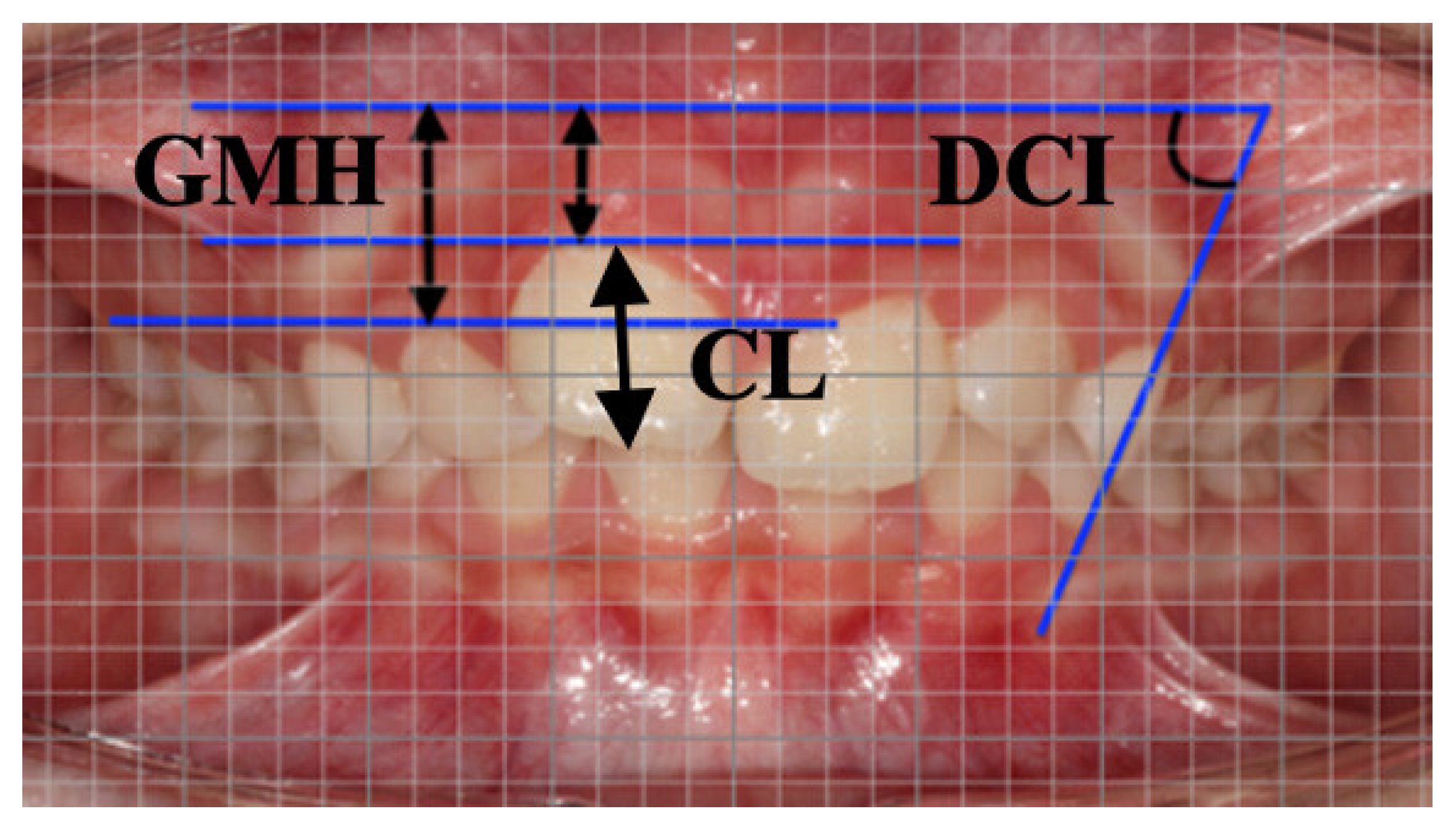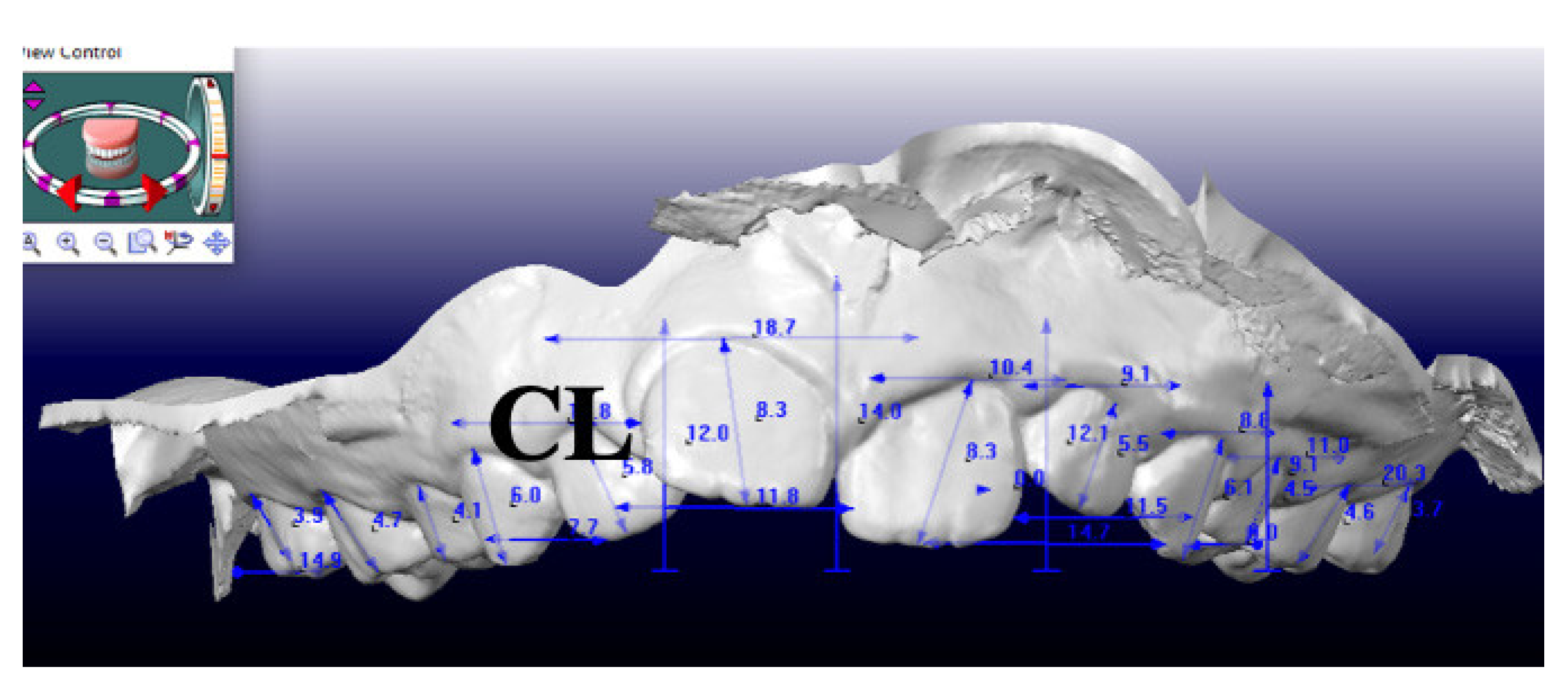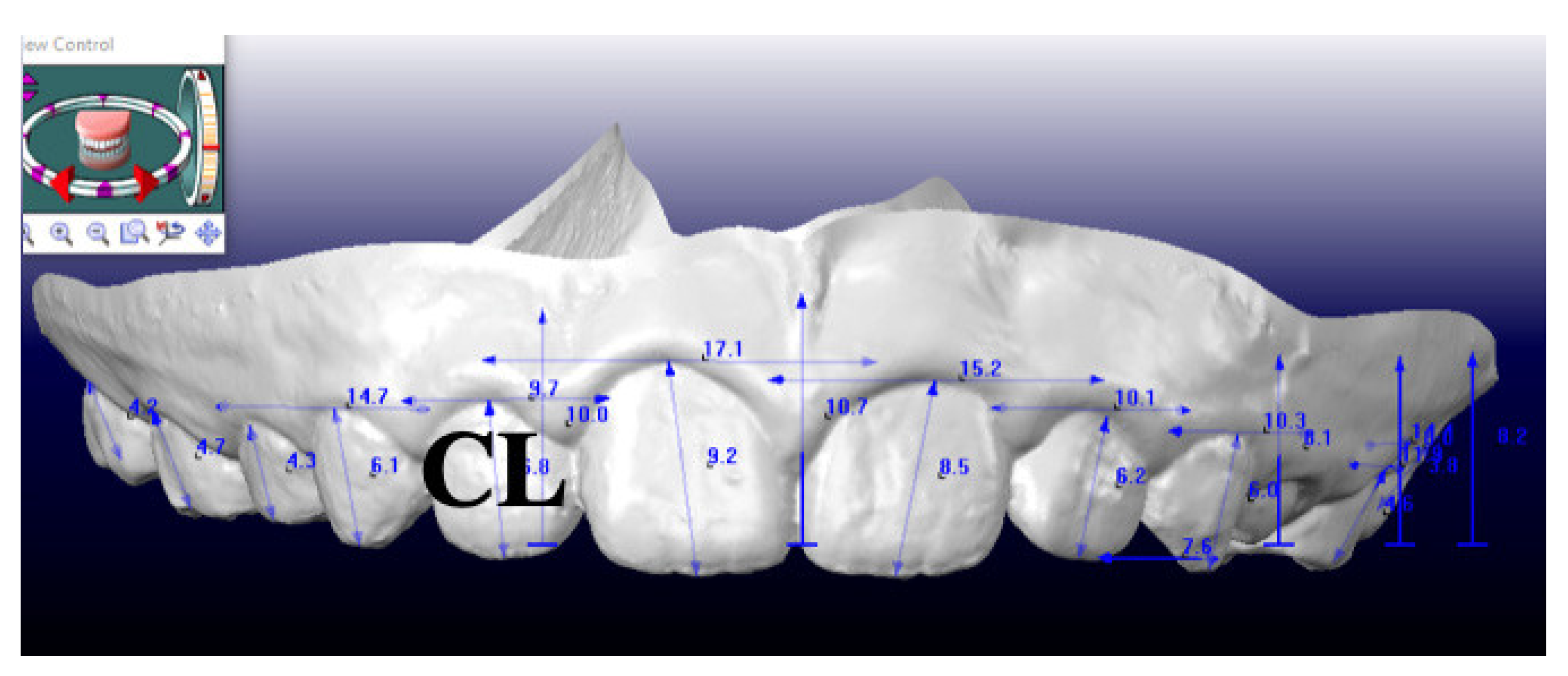Gingival Margins’ Modifications during Orthodontic Treatment with Invisalign First®: A Preliminary Study
Abstract
1. Introduction
2. Materials and Methods
2.1. Treatment Protocol
2.2. Measurements
- Gingival margin height (GMH), perpendicular distance between mucogingival line and apical point of the gingival margin;
- Deciduous Canine Inclination (DCI), angle between long axis of upper deciduous canine and mucogingival line. Mucogingival line was detected by considering mucogingival line of anterior arch segment parallel to occlusal plane.
CL (photograph)
2.3. Statistical Analysis
3. Results
4. Discussion
5. Conclusions
Author Contributions
Funding
Institutional Review Board Statement
Informed Consent Statement
Conflicts of Interest
References
- Blevins, R. Phase I orthodontic treatment using Invisalign first. J. Clin. Orthod. 2019, 53, 73–83. [Google Scholar] [PubMed]
- Galan-Lopez, L.; Barcia-Gonzalez, J.; Plasencia, E. A systematic review of the accuracy and efficiency of dental movements with Invisalign. Korean J. Orthod. 2019, 49, 140–149. [Google Scholar] [CrossRef] [PubMed]
- Caruso, S.; Nota, A.; Caruso, A.; Severino, M.; Gatto, R.; Meuli, S.; Mattei, A.; Tecco, S. Mandibular advancement with clear aligners in the treatment of skeletal Class II. A retrospective controlled study. Eur. J. Paediatr. Dent. 2021, 22, 26–30. [Google Scholar] [PubMed]
- Abraham, K.K.; James, A.R.; Thenumkal, E.; Emmatty, T. Correction of anterior crossbite using modified transparent aligners: An esthetic approach. Contemp. Clin. Dent. 2016, 7, 394–397. [Google Scholar] [CrossRef]
- Levrini, L.; Carganico, A.; Abbate, L. Maxillary expansion with clear aligners in the mixed dentition: A preliminary study withInvisalign® First system. Eur. J. Paed. Dent. 2021, 22, 125–128. [Google Scholar]
- Lanteri, V.; Segù, M.; Doldi, J.; Butera, A. Pre-bonding prophylaxis and brackets detachment: An experimental comparison of different methods. Int. J. Clin. Dent. 2014, 7, 191–197. [Google Scholar]
- Harris, K.; Ojima, K.; Dan, C.; Upadhyay, M.; Alshehri, A.; Kuo, C.L.; Mu, J.; Uribe, F.; Nanda, R. Evaluation of open bite closure using clear aligners: A retrospective study. Prog. Orthod. 2020, 21, 23. [Google Scholar] [CrossRef]
- Khosravi, R.; Cohanim, B.; Hujoel, P.; Daher, S.; Neal, M.; Liu, W.; Huang, G. Management of overbite with Invisalign appliance. Am. J. Orthod. Dentofac. Orthop. 2017, 151, 691–699. [Google Scholar] [CrossRef]
- Rossini, G.; Parrini, S.; Castroflorio, T.; Deregibus, A.; Debernardi, C.L. Periodontal health during clear aligners treatment: A systematic review. Eur. J. Orthod. 2015, 37, 539–543. [Google Scholar] [CrossRef]
- Chhibber, A.; Agarwal, S.; Yadav, S.; Kuo, C.L.; Upadhyay, M. Which orthodontic appliance is best for oral hygiene? A randomized clinical trial. Am. J. Orthod. Dentofac. Orthop. 2018, 153, 175–183. [Google Scholar] [CrossRef]
- Lione, R.; Cretella Lombardo, E.; Paoloni, V.; Pavoni, C.; Cozza, P. Upper arch dimensional changes with clear aligners in the early mixed dentition: A prospective study. J. Orofac. Orthop. 2021. [Google Scholar] [CrossRef]
- Lione, R.; Paoloni, V.; Bartolommei, L.; Gazzani, F.; Meuli, S.; Pavoni, C.; Cozza, P. Maxillary arch development with Invisalign System: Analysis of expansion dental movements on digital dental casts. Angle Orthod. 2021, 91, 433–440. [Google Scholar] [CrossRef] [PubMed]
- Staderini, E.; Patini, R.; Meuli, S.; Camodeca, A.; Guglielmi, F.; Gallenzi, P. Indication of clear aligners in the early treatment of anterior crossbite: A case series. Dent. Press J. Orthod. 2020, 25, 33–43. [Google Scholar] [CrossRef]
- McNamara JAJr Lione, R.; Franchi, L.; Angelieri, F.; Cevidanes, L.H.S.; Darendeliler, M.A.; Cozza, P. The role of rapid maxillary expansion in the promotion of oral and general health. Prog. Orthod. 2015, 16, 33. [Google Scholar] [CrossRef] [PubMed]
- Mucedero, M.; Fusaroli, D.; Franchi, L.; Pavoni, C.; Cozza, P.; Lione, R. Long-term evaluation of rapid maxillary expansion and bite-block therapy in open bite growing subjects: A controlled clinical study. Angle Orthod. 2018, 88, 523–529. [Google Scholar] [CrossRef] [PubMed]
- Pavoni, C.; Paoloni, V.; Ghislanzoni, L.T.H.; Laganà, G.; Cozza, P. Geometric morphometric analysis of the palatal morphology in children with impacted incisors: A three-dimensional evaluation. Angle Orthod. 2017, 87, 404–408. [Google Scholar] [CrossRef] [PubMed]
- Lione, R.; Pavoni, C.; Noviello, A.; Clementini, M.; Danesi, C.; Cozza, P. Conventional versus laser gingivectomy in the management of gingival enlargement during orthodontic treatment: A randomized controlled trial. EJO 2020, 42, 78–85. [Google Scholar] [CrossRef]
- Chu, S.J.; Tan, J.H.-P.; Stappert CF, J.; Tarnow, D.P. Gingival Zenith Positions and Levels of the Maxillary Anterior Dentition. J. Esthet. Restor. Dent. 2009, 21, 113–120. [Google Scholar] [CrossRef]
- Closs, L.Q.; Grehs, B.; Raveli, D.B.; Kuschenbecker, C. Occurrence, extension, and severity of gingival margin alterations after orthodontic treatment. World J. Orthod. 2008, 9, e1–e6. [Google Scholar]
- Alkan, O.; Kaya, Y.; Tunca, M.; Keskin, S. Changes in the gingival thickness and keratinized gingival width of maxillary and mandibular anterior teeth after orthodontic treatment. Angle Orthod. 2021, 91, 459–467. [Google Scholar] [CrossRef]
- Lione, R.; Paoloni, V.; De Razza, F.C.; Pavoni, C.; Cozza, P. The Efficacy and Predictability of Maxillary First Molar Derotation with Invisalign: A Prospective Clinical Study in Growing Subjects. Appl. Sci. 2022, 12, 2670. [Google Scholar] [CrossRef]
- Gazzani, F.; Bellisario, D.; Quadrini, F.; Cozza, P.; Lione, R. Comparison Between Different Composite Resins Used for Clear Aligner Attachments: An In-Vitro Study. Front. Mater. 2022, 8, 789143. [Google Scholar] [CrossRef]
- Closs, L.Q.; Branco, P.; Rizzatto, S.D.; Raveli, D.B.; Rosing, C.K. Gingival margin alterations and the pre-orthodontic treatment amount of keratinized gingiva. Braz. Oral Res. 2007, 21, 58–63. [Google Scholar] [CrossRef] [PubMed]
- Whitehead, A.L.; Julious, S.A.; Cooper, C.L.; Campbell, M.J. Estimating the sample size for a pilot randomized trial to minimize the overall sample size for the external pilot and main trial for a continuous variable. Stat. Methods Med. Res. 2016, 25, 1057–1073. [Google Scholar] [CrossRef]
- Vajaria, R.; BeGole, E.; Kusnoto, B.; Galang, M.T.; Obrez, A. Evaluation of incisor position and dental transverse dimensional changes using the Damon system. Angle Orthod. 2011, 81, 647–652. [Google Scholar] [CrossRef]
- Coatom, G.W.; Behrents, R.G.; Bissada, N.F. The Width of Keratinized Gingiva During Orthodontic Treatment: Its Significance and Impact on Periodontal Status. J. Periodontol. 1981, 52, 307–313. [Google Scholar] [CrossRef]
- Trentini, C.M.; Moriarty, J.D.; Phillips, C.; Tulloch, J.F.C. Evaluation of the Use of Orthodontic Records to Measure the Width of Keratinized Tissue. J. Periodontol. 1995, 66, 438–442. [Google Scholar] [CrossRef]
- Wyrebek, B.; Orzechowska, A.; Cudzilo, D.; Plakwicz, P. Evaluation of changes in the width of gingiva in children and youth. Review of literature. Dev. Period Med. 2005, 19, 212–216. [Google Scholar]




| T0 (n = 18, 8 M 10 F) | T1 (n = 18, 8 M 10 F) | |||||||
|---|---|---|---|---|---|---|---|---|
| Variables | Mean | SD | Mean | SD | Diff | SD | 95% CI | p Value |
| Actual GMH (mm) | ||||||||
| 2° right deciduous molar | 4.55 | 0.59 | 4.32 | 0.90 | −0.22 | 0.92 | −0.285 to 0.745 | NS |
| 1° right deciduous molar | 4.55 | 0.49 | 4.08 | 0.93 | −0.42 | 1.04 | −0.033 to 0.973 | ** |
| Deciduous right canine | 5.36 | 0.59 | 4.49 | 0.60 | −0.87 | 0.69 | 0.466 to 1.273 | *** |
| Lateral right incisor | 5.18 | 0.70 | 4.79 | 0.74 | −0.39 | 0.99 | −0.097 to 0.877 | ** |
| Central right incisor | 5.21 | 0.86 | 4.79 | 0.67 | −0.41 | 1.07 | −0.102 to 0.942 | ** |
| Central left incisor | 5.66 | 0.90 | 5.03 | 0.85 | −0.44 | 1.20 | 0.037 to 1.223 | ** |
| Lateral left incisor | 5.55 | 0.59 | 5.09 | 0.74 | −0.46 | 0.96 | 0.006 to 0.913 | ** |
| Deciduous left canine | 5.71 | 0.62 | 4.83 | 0.70 | −0.86 | 0.89 | 0.432 to 1.327 | *** |
| 1° left deciduous molar | 4.97 | 0.58 | 4.52 | 0.72 | −0.68 | 0.86 | 0.007 to 0.892 | ** |
| 2° left deciduous molar | 5.25 | 0.58 | 5.07 | 0.97 | −0.18 | 1.11 | −0.361 to 0.721 | NS |
| Canine Inclination (°) | ||||||||
| Deciduous right canine | 83 | 4.05 | 89.77 | 6.61 | 7.11 | 6.69 | 3.056 to 10.483 | *** |
| Deciduous left canine | 86.27 | 5.60 | 93.83 | 6.24 | 7.5 | 5.46 | 3.543 to 11.576 | *** |
Publisher’s Note: MDPI stays neutral with regard to jurisdictional claims in published maps and institutional affiliations. |
© 2022 by the authors. Licensee MDPI, Basel, Switzerland. This article is an open access article distributed under the terms and conditions of the Creative Commons Attribution (CC BY) license (https://creativecommons.org/licenses/by/4.0/).
Share and Cite
Lione, R.; Gazzani, F.; Moretti, S.; Danesi, C.; Cretella Lombardo, E.; Pavoni, C. Gingival Margins’ Modifications during Orthodontic Treatment with Invisalign First®: A Preliminary Study. Children 2022, 9, 1423. https://doi.org/10.3390/children9101423
Lione R, Gazzani F, Moretti S, Danesi C, Cretella Lombardo E, Pavoni C. Gingival Margins’ Modifications during Orthodontic Treatment with Invisalign First®: A Preliminary Study. Children. 2022; 9(10):1423. https://doi.org/10.3390/children9101423
Chicago/Turabian StyleLione, Roberta, Francesca Gazzani, Sofia Moretti, Carlotta Danesi, Elisabetta Cretella Lombardo, and Chiara Pavoni. 2022. "Gingival Margins’ Modifications during Orthodontic Treatment with Invisalign First®: A Preliminary Study" Children 9, no. 10: 1423. https://doi.org/10.3390/children9101423
APA StyleLione, R., Gazzani, F., Moretti, S., Danesi, C., Cretella Lombardo, E., & Pavoni, C. (2022). Gingival Margins’ Modifications during Orthodontic Treatment with Invisalign First®: A Preliminary Study. Children, 9(10), 1423. https://doi.org/10.3390/children9101423






